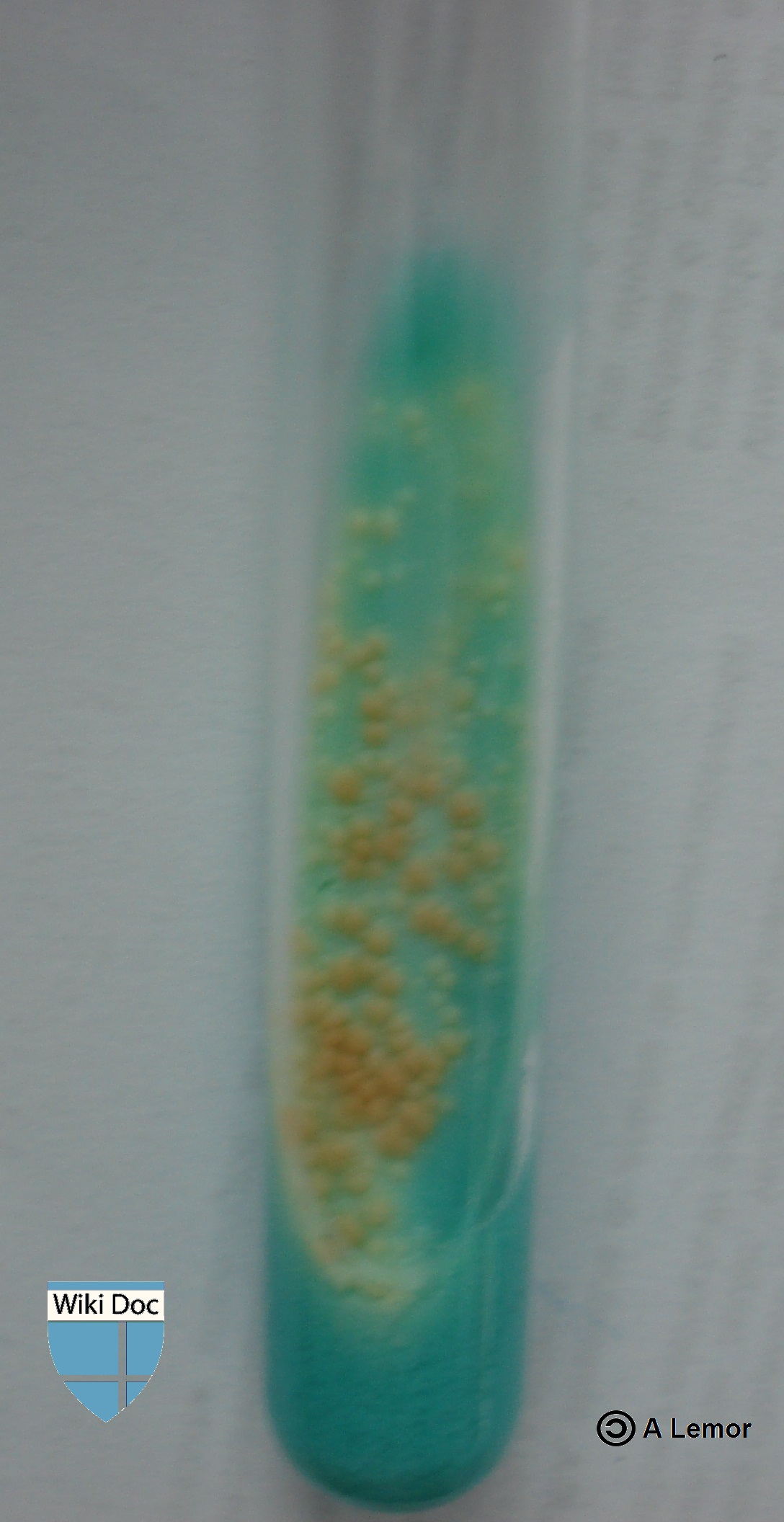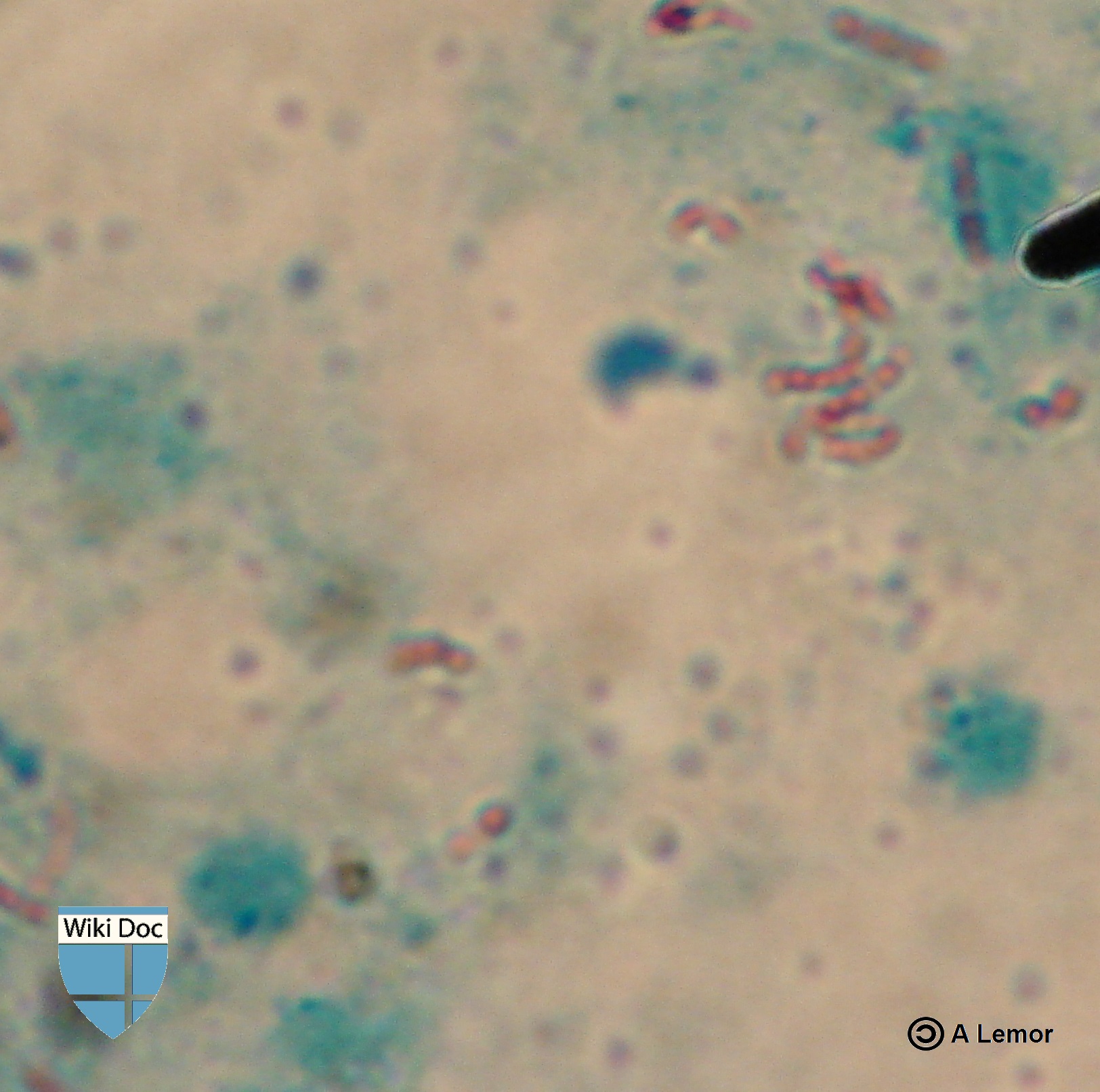Multi-drug-resistant tuberculosis laboratory findings
|
Multi-drug-resistant tuberculosis Microchapters |
|
Differentiating Multi-drug-resistant tuberculosis from other Diseases |
|---|
|
Diagnosis |
|
Treatment |
|
Case Studies |
|
Multi-drug-resistant tuberculosis laboratory findings On the Web |
|
American Roentgen Ray Society Images of Multi-drug-resistant tuberculosis laboratory findings |
|
FDA on Multi-drug-resistant tuberculosis laboratory findings |
|
CDC on Multi-drug-resistant tuberculosis laboratory findings |
|
Multi-drug-resistant tuberculosis laboratory findings in the news |
|
Blogs on Multi-drug-resistant tuberculosis laboratory findings |
|
Directions to Hospitals Treating Multi-drug-resistant tuberculosis |
|
Risk calculators and risk factors for Multi-drug-resistant tuberculosis laboratory findings |
Editor-In-Chief: C. Michael Gibson, M.S., M.D. [1]; Associate Editor(s)-in-Chief: Alejandro Lemor, M.D. [2]
Overview
Routine laboratory exams are usually in the normal ranges. The presence of acid-fast-bacilli (AFB) on a sputum smear or other specimen often indicates TB disease and a positive culture for M. tuberculosis confirms the diagnosis. Other laboratory test include peritoneal fluid or CSF analysis, urinalysis, and Interferon-Gamma release assays. The Xpert MTB/RIF test is a molecular test that detects the DNA of the M. tuberculosis and resistance to rifampin. The use of this test has increased in the past years.
Laboratory Findings
Routine laboratory exams are usually in the normal ranges. In some patients the following abnormalities may be observed:
- Mild normocytic anemia may be present in almost half of patients.
- Increased erythrocyte sedimentation rate (ESR)
- Mild leukocytosis
- Hyponatremia
- Hypercalcemia
- Elevated alkaline phosphatase levels
- Mild elevation of liver enzymes
- Findings of adrenal insufficiency in case of adrenal involvement (low cortisol and aldosterone levels)
Acid-Fast Bacili
The presence of acid-fast-bacilli (AFB) on a sputum smear or other specimen often indicates TB disease. Acid-fast microscopy is easy and quick, but it does not confirm a diagnosis of TB because some acid-fast-bacilli are not M. tuberculosis. Therefore, a culture is done on all initial samples to confirm the diagnosis.
Sputum smears and cultures should be done for acid-fast bacilli if the patient is producing sputum. The preferred method for this is fluorescence microscopy (auramine-rhodamine staining), which is more sensitive than conventional Ziehl-Neelsen staining.[1]
If no sputum is being produced, specimens can be obtained by inducing sputum, gastric washings, a laryngeal swab, bronchoscopy with bronchoalveolar lavage, or fine needle aspiration of a collection. A comparative study found that inducing three sputum samples is more sensitive than three gastric washings.[2]
Other mycobacteria are also acid-fast. If the smear is positive, PCR or gene probe tests can distinguish M. tuberculosis from other mycobacteria. Even if sputum smear is negative, tuberculosis must be considered and is only excluded after negative cultures.
Culture
A positive culture for M. tuberculosis confirms the diagnosis of TB disease. Culture examinations should be completed on all specimens, regardless of AFB smear results. Laboratories should report positive results on smears and cultures within 24 hours by telephone or fax to the primary health care provider and to the state or local TB control program, as required by law.
Many types of cultures are available for M. tuberculosis, this include Löwenstein-Jensen (LJ), Kirchner, or Middlebrook media. [3]. Culture of Mycobacteria usually takes 4 to 8 weeks to grow and can distinguish from several types of mycobacteria Other forms of culture are available, this include automated systems in which the mycobacteria grow at a faster rate. MB/BacT, BACTEC 9000, and the Mycobacterial Growth Indicator Tube (MGIT). The microscopic-observation drug-susceptibility (MODS) culture is considered a faster and more accurate method [4][5].
 |
 |
A sample of pleural exudate can be analyzed by cytopathology or at a cell count lab. Samples are usually lymphocyte predominant, and cytopathology is more accurate than cell count labs at detecting lymphs. If there is more fluid present, then an AFB lab is more appropriate. A pleural exudate lab test may find sterile pyuria (especially in HIV positive patients), but overall this finding is fairly uncommon. Most extra-pulmonary TB is pauci-bacillary, so the yield of tests is very low. A negative results does not exclude a tuberculosis infection.
Drug Resistance
For all patients, the initial M. tuberculosis isolate should be tested for drug resistance. It is crucial to identify drug resistance as early as possible to ensure effective treatment. Drug susceptibility patterns should be repeated for patients who do not respond adequately to treatment or who have positive culture results despite 3 months of therapy. Susceptibility results from laboratories should be promptly reported to the primary health care provider and the state or local TB control program.
Fluid Analysis
- Peritoneal Fluid: Leucocyte count: 150-4000 mm³, lymphocytic pleocytosis, protein > 3.0 g/dL, increased LDH.
- Cerebrospinal Fluid: High protein, low glucose, increased number of lymphocytes, increased LDH
Urinalysis
- For renal tuberculosis, the classic laboratory finding is sterile pyuria with microscopic hematuria.
Interferon-Gamma Release Assays (IGRAs)
Interferon-Gamma Release Assays (IGRAs) are whole-blood tests that can aid in diagnosing Mycobacterium tuberculosis infection. They do not help differentiate latent tuberculosis infection (LTBI) from tuberculosis disease. Two IGRAs that have been approved by the U.S. Food and Drug Administration (FDA) are commercially available in the U.S, The QuantiFERON®-TB Gold In-Tube test (QFT-GIT) and the T-SPOT®.TB test (T-Spot).
IGRAs measure a person’s immune reactivity to M. tuberculosis. White blood cells from most persons that have been infected with M. tuberculosis will release interferon-gamma (IFN-g) when mixed with antigens (substances that can produce an immune response) derived from M. tuberculosis.
To conduct the tests, fresh blood samples are mixed with antigens and controls. The antigens, testing methods, and interpretation criteria for IGRAs differ.
| QuantiFERON | T-SPOT | |
|---|---|---|
| Initial Process | Process whole blood within 16 hours | Process peripheral blood mononuclear cells (PBMCs) within 8 hours, or if T-Cell Xtend® is used, within 30 hours |
| M. tuberculosis Antigen | Single mixture of synthetic peptides representing ESAT-6, CFP-10 & TB7.7. | Separate mixtures of synthetic peptides representing ESAT-6 & CFP-10 |
| Measurement | IFN-g concentration | Number of IFN-g producing cells (spots) |
| Possible Results | Positive, negative, indeterminate | Positive, negative, indeterminate, borderline |
| Table adapted from CDC [6] | ||
| Advantages | Disadvantages |
|---|---|
|
|
| Table adapted from CDC Interferon-Gamma Release Assays[6] | |
CDC Recommendations on When to Use IGRA Tests Adapted from CDC Interferon-Gamma Release Assays[6]
- IGRAs can be used in place of (but not in addition to) TST in all situations in which CDC recommends TST as an aid in diagnosing M. tuberculosis infection, with preferences and special considerations noted below.
- This includes contact investigations, testing during pregnancy, and screening of health care workers and others undergoing serial evaluation for M. tuberculosis infection.
- Despite the indication of a preference, use of the alternative test (FDA-approved IGRA or TST) is acceptable medical and public health practice.
- Caution in interpretation should be used when testing certain populations because of limited data on the use of IGRAs
- Populations in which IGRAs are preferred for testing:
- Persons who have received BCG (either as a vaccine or for cancer therapy)
- Persons from groups that historically have poor rates of return for TST reading.
- TST is preferred over IGRAs for testing children less than 5 years of age.
- As with TST, IGRAs generally should not be used for testing persons who have a low risk of infection and a low risk of disease due to M. tuberculosis.
- Each institution and TB control program should evaluate the availability and benefits of IGRAs in prioritizing their use.
Routine testing with both TST and IGRA is not recommended. However, results from both tests might be useful in the following situations:
| When the initial test is negative and: | When the initial test is positive and: |
|---|---|
|
|
| Table adapted from CDC[6] | |
- In addition, repeating an IGRA or performing a TST might be useful when the initial IGRA result is indeterminate, borderline, or invalid and a reason for testing persists.
- Multiple negative results from any combination of these tests cannot exclude M. tuberculosis infection. Steps should be taken to minimize unnecessary and misleading testing of persons at low risk.
- Selection of the most suitable test or combination of tests for detection of M. tuberculosis infection should be based on the reasons and the context for testing, test availability, and overall cost of testing.
Xpert MTB/RIF Test
- The Xpert MTB/RIF test is a molecular test that detects the DNA of the Mycobacterium tuberculosis complex (MTBC) and genetic mutations associated with resistance to rifampin (RMP) in unprocessed sputum and concentrated sputum sediments [7]
- WHO recommends the Xpert MTB/RIF test for the initial diagnosis of MDR-TB or HIV-TB co-infection.[8]
- The advantages of this rapid TB test are the following:[8]
- Detects M. tuberculosis and rifampicin drug resistance simultaneously.
- Results are available in < 2 hours so the patient can be treated the same day of the test.
- The bio-safety requirements and training are minimal.
- It can be stored in non-conventional laboratories.
References
- ↑ Steingart K, Henry M, Ng V; et al. (2006). "Fluorescence versus conventional sputum smear microscopy for tuberculosis: a systematic review". Lancet Infect Dis. 6 (9): 570&ndash, 81. doi:10.1016/S1473-3099(06)70578-3.
- ↑ Brown M, Varia H, Bassett P, Davidson RN, Wall R, Pasvol G (2007). "Prospective study of sputum induction, gastric washing, and bronchoalveolar lavage for the diagnosis of pulmonary tuberculosis in patients who are unable to expectorate". Clin Infect Dis. 44 (11): 1415–20. doi:10.1086/516782. PMID 17479935.
- ↑ Drobniewski F, Caws M, Gibson A, Young D (2003). "Modern laboratory diagnosis of tuberculosis". Lancet Infect Dis. 3 (3): 141–7. PMID 12614730.
- ↑ Moore D, Evans C, Gilman R, Caviedes L, Coronel J, Vivar A, Sanchez E, Piñedo Y, Saravia J, Salazar C, Oberhelman R, Hollm-Delgado M, LaChira D, Escombe A, Friedland J (2006). "Microscopic-observation drug-susceptibility assay for the diagnosis of TB". N Engl J Med. 355 (15): 1539–50. PMID 17035648.
- ↑ Minion, Jessica; Leung, Erika; Menzies, Dick; Pai, Madhukar (2010). "Microscopic-observation drug susceptibility and thin layer agar assays for the detection of drug resistant tuberculosis: a systematic review and meta-analysis". The Lancet Infectious Diseases. 10 (10): 688–698. doi:10.1016/S1473-3099(10)70165-1. ISSN 1473-3099.
- ↑ 6.0 6.1 6.2 6.3 "CDC Interferon-Gamma Release Assays (IGRAs) - Blood Tests for TB Infection".
- ↑ "Availability of an Assay for Detecting Mycobacterium tuberculosis, Including Rifampin-Resistant Strains, and Considerations for Its Use — United States, 2013".
- ↑ 8.0 8.1 "WHO Tuberculosis Diagnosis Xpert MTB/RIF Test 2013" (PDF).
